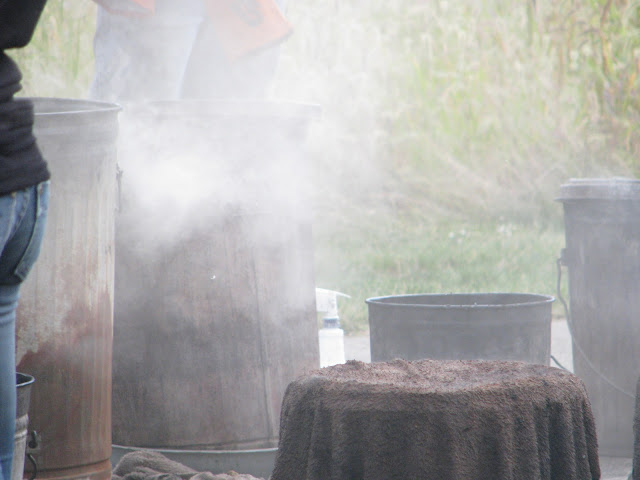What a beautiful day for raku! Raku is a method of firing pottery outside using a modernized version of an ancient Japanese technique. Raku is different because the glazes get beautiful metallic lusters and flashing. Some glazes are crackle and any area of exposed clay where there is no glaze will turn sooty black.
Student pottery that has been glazed and is waiting to be fired.
The pots are loaded into the kiln where they will be fired to about 2000 degrees fahrenheit. The process is quick compared to other glaze fire methods. The kiln reaches temperature in about 30 minutes.
The pots here are glowing red hot and the surface is liquid. Now the fun begins!
The pots are removed from the kiln when they are glowing red hot and put into the reduction chambers (aka garbage cans!) with combustible materials like straw or paper.
The contents light on fire and then the lid is put on to cause a reduction or "starve" the oxygen from the atmosphere inside the chamber. That's how the glazes get all their special effects.
Lots of smoke is produced but we put wet towels over the cans to try and keep it from becoming too bad.
The pots are taken from the garbage cans after about ten minutes. They are still very hot and we quench them in water to freeze the effects in place.
Look at all the student work! And this is only about half of what we completed.

There are some periods where we are waiting around for the pots to fire so we drag a couple of wheels outside so students can practice throwing on the wheel.
We also make horse hair pottery during the workshop. The pots are fired until red hot and then horse hair is burned onto the hot clay surface. It really only sticks to unglazed areas and this student did half glaze and half horse hair.
This is my work for the day! I have to admit that I did not throw the large vase but I did glaze it.
I'm hoping this will be one of our big ticket items at our Art Faire!













What lovely pots, I have a hankering to do some pottery but cannot find anywhere locally that does it. Your students are so lucky, thankyou for sharing this work.
ReplyDeleteThat looks hot, and very difficult to do. They are lovely though.
ReplyDeleteI am Fickle Cattle.
Thanks for the comments! I'm new to this so it's exciting for me to get them.
ReplyDeleteFickle Cattle I really like your blog. Unlike you I am not very good with words, I am more visually literate but I love reading and I find your words very thought provoking!
raku is so much fun ... you can see a couple of the experimental firings we did at school here http://paulavalentimceramics.blogspot.com/search/label/firing%20processes (I need to update this blog!) and some of my raku pieces in here http://www.flickr.com/photos/paulavalentim/sets/72157610555333267/ ... :)
ReplyDeletein relation to your question those pebble vases are not glazed inside. first I bisque them at 900ºC because I still need to polished them and then I take them to 1250ºC-1260ºC which is around cone 8 or 9 I think (Orton Pyrometric Cones) I don't really use cones since my electric kiln has a controller. the porcelain I use maturates well at this temperature and it can hold water.
thanks for your interest and comments ...
How did you create the copper look on the bottom pot? I've been looking everywhere for some kind of directions on how to do that and I can't find anything. Please help!
ReplyDelete